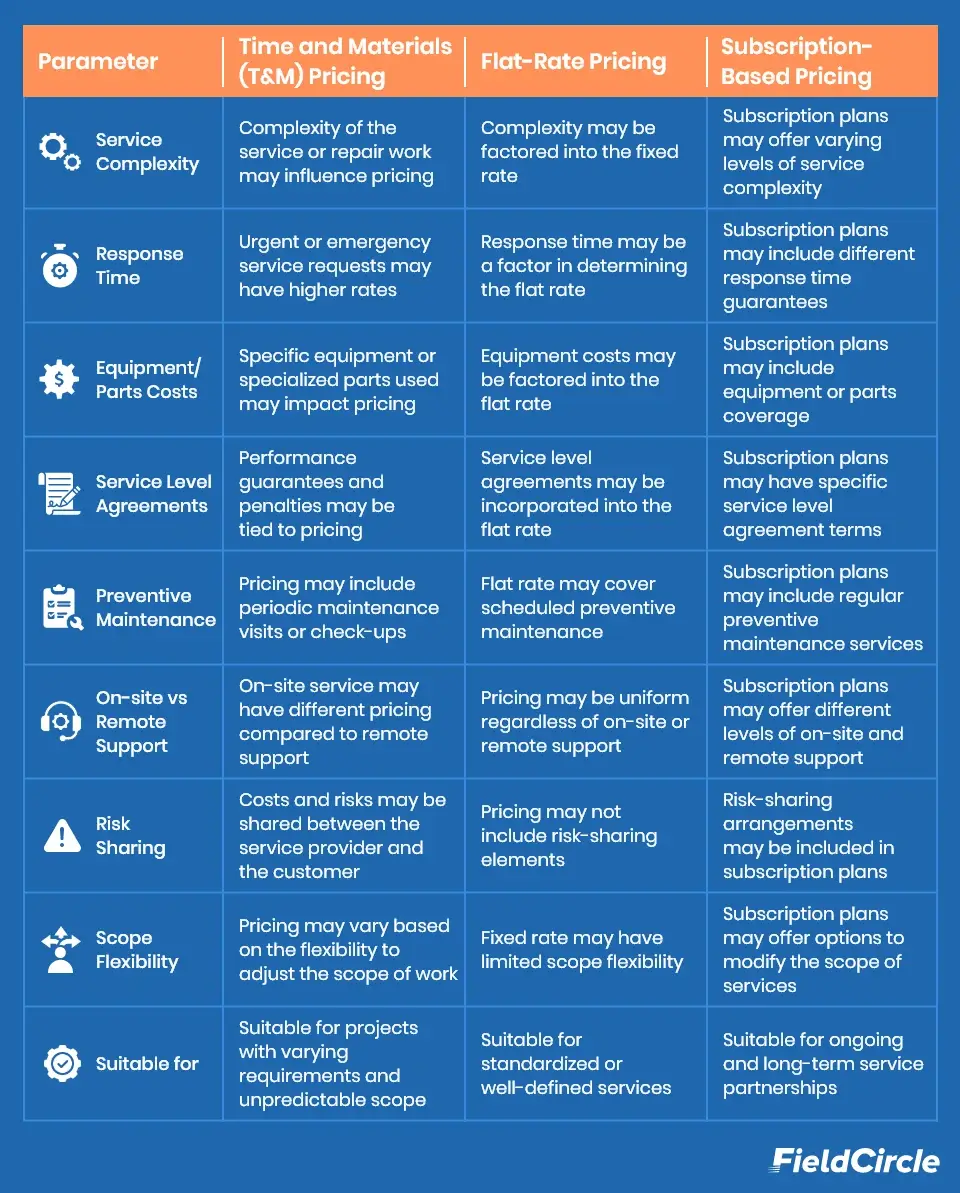How to Price Your Field Service Contracts- Best Practices and Strategies

Pricing your field service contracts can be tricky. If you set prices too high, you might lose out on valuable sales. By setting prices too low, you risk losing out on valuable revenue.
MIT Sloan Review says even a small price change can boost or lower your revenue by 20-50%. So, accurately pricing field contracts matters for your business’s profitability, for which you need the best pricing strategies.
With the right pricing strategy, you can set prices that your customers want to pay. Various pricing models and strategies are available to help you determine the right prices for your target audience and revenue goals.
Remember, customer opinions about pricing can change over time. So, today we will equip you with different pricing strategies and their significance. Remember that you must keep evaluating and refining your pricing strategies to stay competitive and satisfy your customers while achieving your financial goals.
What is a Service Contract and Its Challenges:
Service contracts are agreements between service providers and their customers that outline the terms and conditions of the services provided. These contracts often cover ongoing maintenance, repairs, or support for equipment or systems.
Thus, Service contract management comes with its own complexities that make pricing strategies challenging for service providers. By delving into these challenges, providers can better navigate the intricacies and devise effective pricing strategies. Let’s explore some key challenges:
Understanding Technical Complexities
Field service agreements have unique requirements and specifications. This means that each job may differ, and service providers must pay attention to specific details.
The scope and duration of the services can also vary. Some jobs may be quick, while others might take a long time. As a service provider, you need to plan accordingly and ensure you can handle different types of work.
When working with customers, you need to integrate with their systems and processes. You must understand how your customers work and adjust your services to fit their needs.
Competitive Landscape
In the field service world, many other companies compete for customers. Therefore, you must analyze the market and understand your competitors’ actions.
It’s also important to know what customers expect and prefer. By understanding their needs, service providers can offer something that stands out and makes them the top choice.
But it’s not just about price! You need to find ways to be different from your competitors in other ways too. This could be through better service quality, faster response times, or additional benefits they offer.
Profitability Considerations
You need to think about making a profit too. And so, you must calculate the costs involved in delivering your services. This includes things like equipment, materials, and paying your employees.
There are also overhead expenses that are not directly related to a specific job. You need to allocate your resources wisely to keep everything running smoothly.
Finally, you have to calculate how much profit you want to make. This means deciding on a margin, which is the difference between the service cost and the price you charge the customer.
By understanding these challenges, you can plan better, stand out from the competition, and ensure you are making enough money to keep your business going.
Common Pricing Models for Field Service Contracts: Making Sense of Different Approaches
Service providers use different pricing models in service contracts to determine how much to charge their customers. Let’s look at common pricing models and how they apply to various industries.
Time and Materials (T&M) Pricing
T&M pricing is like a “pay-as-you-go” approach. Service providers charge based on the time spent working and the materials used for the job. For instance, in Oil and Gas Enterprises, this pricing model may apply when repairing pipelines or maintaining drilling equipment.
Pros of T&M Pricing:
- Allows for flexibility in billing, as customers pay for the actual work done.
- Works well for complex projects with uncertain timelines.
Cons of T&M Pricing:
- It can take time to accurately estimate the final cost, leading to potential customer disagreements.
Factors To Consider: Labor rates, material costs, project complexity, and service provider’s charge.
Flat-Rate Pricing
Flat-rate pricing is a model with a fixed price for a specific service. It’s similar to buying a product with a set price tag. For example, this pricing model may apply to Industrial Equipment Enterprises when servicing machines or installing equipment.
Pros of Flat-Rate Pricing:
- Customers know the exact cost upfront, which offers transparency.
- It simplifies billing and helps customers budget effectively.
Cons of Flat-Rate Pricing:
- Service providers may need to adjust the pricing accordingly if unexpected issues arise during the job.
Factors to Consider: Average time and costs for similar services.
Subscription-Based Pricing
Subscription-based pricing is like subscribing to a service for a certain period, paying a recurring fee. This model is common in software services or ongoing maintenance contracts. For instance, in the Construction Industry, service providers may offer ongoing site inspections and consultations on a subscription basis.
Pros of Subscription-Based Pricing:
- It ensures a steady revenue stream for service providers.
- Customers receive continuous support and maintenance services.
Cons of Subscription-Based Pricing:
- Determining the right pricing tiers and features can be complex, as providers need to offer value that justifies the recurring fees.
Factors to Consider: Level of service or support provided, service delivery frequency, size or complexity of the customer’s operation, and market demand. These factors help determine appropriate pricing tiers and features that align with the value provided to customers.

Value-Based Pricing Strategies
Regarding pricing service contracts, value-based pricing strategies can be incredibly effective. These strategies focus on determining the price based on the service’s value to the customer. Let’s explore three key value-based pricing strategies and understand how you can apply to service contracts.
Pricing based on Key Value Drivers
To set the right price for a field service contract, it’s essential to identify the critical value drivers. This means understanding what customers want and need. As the CEO of FieldCircle, Yogesh Choudhary, says, “Listening to what people need and understanding what motivates them, you can offer the perfect solution and show how you can help. It’s like being a mind reader for what people want”.
You can do this by listening to customer pain points and goals. Then, by mapping your service offerings to meet these needs, you can create a pricing strategy that aligns with the value you provide.
For instance, a service provider in the Facilities Management Industry might identify that their customers want quick response times for maintenance issues. They can address this key value driver by offering expedited services and charging accordingly.
Differentiation and Premium Pricing
The concept of differentiation revolves around setting your company apart from competitors by offering something distinct and valuable. It involves creating a compelling value proposition showcasing your business’s unique benefits and advantages. Premium pricing, on the other hand, involves charging higher prices that reflect the added value and quality customers receive when choosing your products or services.
Companies can communicate their expertise, exceptional service quality, and innovative solutions to potential customers by implementing differentiation and premium pricing strategies. For this:
Create a Unique Value Proposition:
To differentiate your business, developing a value proposition that sets you apart from competitors is essential. Emphasize your expertise, exceptional service quality, and innovative solutions to showcase what makes you unique.
For instance, draw inspiration from companies like Apple, known for their unwavering commitment to customer satisfaction. By going above and beyond, Apple has successfully justified premium prices, with customers willing to pay more for the peace of mind and exceptional experience they provide.
Communicate the Added Value of Your Services:
Effectively communicating the benefits and advantages that customers gain by choosing your services is vital to justify premium prices. Highlight the tangible and intangible value customers receive, such as time savings, personalized support, or access to exclusive features.
Incorporating Tony Robbins’ quote, “Success leaves clues. People who succeed at the highest level are doing something differently than everyone else does,” reminds us of the importance of standing out and conveying that differentiation to customers.
Have Strategies for Charging Premium Prices:
To charge premium prices, it is crucial to differentiate your services and justify the higher costs. For example, differentiate yourself by offering specialized equipment and highly skilled technicians. Then, effectively communicate the value of your expertise and premium service to customers, demonstrating why your prices are justified. By showcasing the unique value you bring, you can position your business as a leader in the industry, commanding higher prices for your service contracts.
Performance-Based Pricing
Performance-Based Pricing is a strategic approach that directly ties the cost of a service to measurable outcomes and results. By establishing key performance indicators (KPIs), service providers can align their pricing with the value they deliver.
By linking pricing to measurable outcomes, service providers ensure that their clients pay for the actual value they receive.
For instance, a field service company can guarantee a machine’s uptime to be 99.9 percent as part of a performance-based contract. This allows the company to charge a premium price for their services, as they commit to delivering exceptional results and minimizing downtime.
Establishing clear KPIs is essential in performance-based pricing. These indicators serve as benchmarks for evaluating the performance of the service provider. They can include metrics like on-time delivery, quality standards, or customer satisfaction levels. By setting and tracking these KPIs, the service provider and the customer clearly understand the expected results, creating transparency and accountability.
Performance-based pricing also encourages the negotiation of win-win agreements with customers. By collaborating on pricing structures that align with performance targets, both parties share the benefits of successful outcomes.
Optimizing Prices and Being Flexible in Field Service Contracts
When pricing field service contracts, you must continually review and analyze your pricing strategies to ensure you are practical and profitable. Let’s explore some key aspects of pricing optimization and flexibility.
Pricing Review and Analysis
Service providers regularly monitor their prices to see if they are working well and making a profit. Then, they evaluate their pricing strategies by examining what’s happening in the market.
If they notice that other companies charge higher prices for similar services, they may consider adjusting their prices accordingly.
Data analytics is a helpful tool in pricing optimization. Service providers can use data to understand customer preferences, market trends, and the services’ costs. This helps them make informed decisions about their pricing strategies.
Discounting and Incentive Programs
Discounts can be a useful way to attract and keep customers. Service providers may offer special lower prices or promotions to encourage customers to choose their services. For instance, a service provider in the Facilities Management Industry may offer a discounted rate for a one-time maintenance service to attract new customers.
Incentive programs are another way to reward loyal customers. Service providers can create programs where customers earn points or rewards for using their services regularly. This encourages customers to keep coming back and helps build strong relationships.
However, you need to be careful with discounts. You need to ensure you are not offering too many discounts that could hurt profitability. Finding the right balance between attracting customers and maintaining profitability is crucial.
Using Negotiation
When discussing prices with customers, you should use negotiation techniques to reach mutually agreeable terms. You can address any concerns or objections that customers may have about the pricing. Like in the construction industry, a service provider may negotiate with a client about the cost of a large-scale renovation project.
Building long-term customer relationships is key. You should aim to create a positive customer experience and understand their needs. This helps in establishing trust and loyalty, which can lead to more business opportunities in the future.
Conclusion
It’s important to find the right balance between making money and having prices that attract customers. You need to set prices that are fair and competitive.
You can figure out the best way to set your prices by using different pricing strategies and testing them out. You can try things like charging for the time and materials or having a fixed price for a specific service. You can also offer subscription-based pricing, where customers pay a recurring fee for ongoing support.
To streamline your field service operations and enhance pricing management, leveraging the best field service management software is recommended. These software solutions provide valuable features and tools to help you analyze pricing data, track costs, and implement various pricing strategies effectively.


